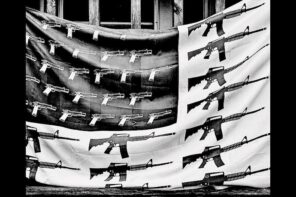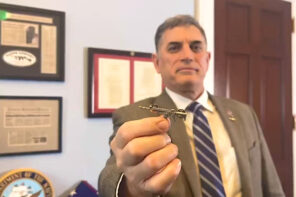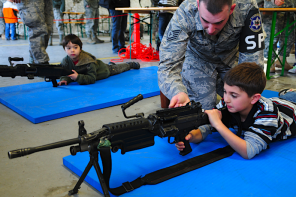Gary Laderman’s essay on the quasi-religious resonance of the gun culture in America (“Hate the Sinner, Love the Gun,” Religion Dispatches, April 18) established some deep and provocative connections between the way religions function and the way our gun culture does. Perhaps most striking was NRA president Wayne LaPierre’s explicit connection of guns with “our way of life,” and implicitly, its defense. It is that implicit appeal to guns as a tradition that struck a real chord with this scholar of religion, and it warrants further analysis.
In order to do so, I would like to add one further category to the analysis of the complex of cultural issues raised by the politics of gun ownership: scripture. As is especially clear in Protestant forms of Christianity, the relationship between tradition and scripture is a layered and contentious one. But when push comes to shove, scripture trumps tradition. So for all the obvious importance of deep cultural myths like the wild west, the sheriff as lone justice, and the like, there is also a crucial democratic scripture repeated almost like a mantra in debates about guns and gun control: it is the Second Amendment to the Constitution.
Like most scriptures that are invoked rather than read (one thinks of Leviticus 18:22, or John 3:16), the text comes to serve a symbolic function often very much at odds with its literal meaning. So, too, with the Second Amendment, which reads as follows:
A well regulated Militia, being necessary to the security of a free State, the right of the people to keep and bear Arms shall not be infringed.
Tempting as it might be to explore the reason why “Militia” and “State” and “Arms” are capitalized but “the people” are not, I want to emphasize what seems critical to the invocation of the Second Amendment by the NRA. They focus on the conclusion, and ignore the reasoning which led to it. The conclusion of this Second Amendment is that “the people” retain the right “to keep and bear Arms.” But why? Because a “well-regulated Militia is necessary to the security of a free State.” The people retain the right to bear arms, that is to say, in defense of the State, since they may be called up in their capacity as a Militia to such a defense. The right to bear arms is related to the duty to be drafted into the nation’s defense.
The fact is that the constitutional framers were at best highly ambivalent about having a standing army. They were more comfortable with a potential (and decentralized) Militia that could be called up as needed to defend the State against foreign and domestic threats. They certainly would have been appalled by the size and scale of the US military today, with its extensive and continually growing branches. And that great octopus, the Pentagon, would have represented everything they despised about Britain and her aggressive imperial reach. That is why the Constitution is maddeningly vague about whether and how we should have a standing military at all.
Article 1, Section 8 clearly lays responsibility for all military matters with the legislative branches of government. The Congress alone makes declarations of war. The Congress alone may “raise and support armies,” but is not supposed to do so “for a longer Term than two years.” The Congress is to “provide and maintain a Navy.” The Congress alone “calls forth the Militia to execute the Laws of the Union, suppress Insurrections and repel Invasions.” And the Congress is in sole charge of “organizing, arming and disciplining” the aforesaid Militia.
Article 2, Section 2 declares the President to be “Commander in Chief of the Army and the Navy of the United States, and of the Militia of the several states, when called into actual service.”
So it seems as if the framers envisioned a situation in which the United States would have an army and a navy, suitably small, and that the lion’s share of our military forces would be called up only in time of war: whether due to domestic rebellion or foreign invasion. They clearly could not conceive of a circumstance in which we would declare a war for other than defensive reasons, and then only under duress. They also seemed unable to believe that such a conflict could last more than a couple of years.
The people’s right to bear arms, then, is appended to the founding documents which lay out a rough and rather vague architecture of governance. The central principle of that architecture is to avoid the creation of an independent military branch of government with a professional military class. Civilian control of the military forces is the central premise on which our system is based, still today, and our military administrators’ commitment to that time-honored principle has been laudable. Congress is responsible for the creation and control of the military. The President will serve as commander-in-chief. And the possibility of raising additional forces (the Militia marshaled by each individual state as a supplement to our national armed forces) is the reason why “the people” maintain “the right to keep and bear arms.”
We no longer live in that world. Congress’ deference to a professional military class of virtually priestly stature is legendary, and a matter for grave embarrassment. The President demonstrates little concern for the responsibilities and ethical complexities of centralized modern warfare; he contents himself with the bluster and bombast of his own rhetoric. Two military branches have become five: the Marines, the Air Force, and the Coast Guard are now independent parts of the mix. And quasi-military branches grow spectacularly in the wake of the September 11 attacks. The Centers for Disease Control are a part of the uniformed service; there is an enormous new bureaucracy called the “Department of Homeland Security” (wasn’t this what the Army and Navy were supposed to be for, under the Constitution?). And the state Militias which were the sole purpose for the Second Amendment to the Constitution are now called “National Guard.” None of these units are staffed by “people” who bring their own arms to such service. The guns, like the training, are provided by the central government, a chilling fact lost on most gun lobbyists.
Our massive military machine could not be more centralized, nor more overwhelming in its power. “The people” would not stand a chance if ever inclined to armed rebellion. Why not? Because the federal government does “infringe the rights of the people” to “keep and bear Arms.” We the people are not permitted to keep and bear nuclear arms, chemical arms, tanks, bazookas, field artillery, etcetera. It is rare for us to be permitted firecrackers with which to celebrate the Fourth of July.
If you tease out the logic that lay behind the Second Amendment, you will see how very far we have strayed from the original vision of the US Constitution. And in this new world, the meaning of that Amendment will need to be very different; it already is.
One of the most striking errors that recurs on nearly every test or paper I receive in my college classes is the confusion of the word “cannon” with the word “canon.” Cannon are weapons, of course, which would seem to have nothing to do with Bibles. But then, scriptures can indeed be used as weapons. They shouldn’t be, but they often are in the context of a “culture war.” And it is in this precise sense that the Second Amendment has attained scriptural status, for better and for worse, in our current political culture.




